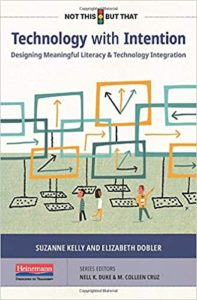Knowing WHEN to Use Technology in Class
Technology with Intention: Designing Meaningful Literacy & Technology Integration
By Suzanne Kelly and Elizabeth Dobler
(Heinemann, 2021 – Learn more)
Reviewed by Kathleen Palmieri

Two teacher educators – Suzanne Kelly & Elizabeth Dobler – have written a book that does not simply guide us through incorporating technology into our classrooms. Kelly and Dobler also pose questions that help us decide whether or not to use technology. They ask us to consider our intention and how we integrate the technology with our specific plan for instruction.

Section Two asks, “What Works? Technology That Supports Active Literacy Learning,” and Section Three explores “Responsive Planning of Technology for Literacy Learning.”
Readying teachers and students to use tech
There are many factors surrounding the use of educational technology that need serious consideration. The first is the overwhelming feelings and discomfort some teachers face when asked to keep up with the latest trends.
Sometimes we are so overwhelmed with everything we have to do that we succumb to pressure from colleagues or supervisors to keep up with technology, drawing on what others are doing rather than making decisions on our own. Without an informed sense of purpose, even the best tech will be poorly used.” (page 8)
Then we need to know our students, their needs, and what technology they have available to them, along with their level of skill is using the tech successfully. Equity becomes an issue when not all students have the tech tools available to succeed at learning virtually.
On page 48, Figure 3-2 offers a “Family Survey for Digital Access,” helping to determine need. On page 49 we find Figure 3-3, “Common Problems and Solutions for Digital Access.” Both these resources underscore the point that technology can’t simply be put out as a tool without providing the necessary instruction to use it and explaining the purpose for its use.
The human side of tech
As Kelly and Dobler discuss using technology effectively with digital literacy, we are reminded that “…simply putting devices into the hands of students is not enough” (page 14). While digital software may be able to detect a student’s reading level and track progress, it can’t replace the relationship that develops between student and teacher during a reading conference.
The physical cues and conversational clues that emerge in a conference are not detected by a software program. There needs to be a balance between digital and non-digital reading assessments and opportunities. “A teacher needs to have a strong knowledge of literacy goals, outside of the technology realm, to know how to utilize digital tools to their best advantage.” (page 54)
Offering both print and digital text is necessary, but students need to be some special skills that help them read digital texts effectively. Figure 3-9, “Prompts for Understanding Multimedia Texts” is a good teaching resource (page 59).
Integrating tech into curriculum
Inquiry based learning is an area where technology can enhance a student’s learning experience. The authors offer examples such as viewing time lapse plant growth to offer a deeper understanding of plant life – or using Google Maps/Earth to visit sites such as a World War II European battleground or Shakespeare’s birthplace in Stratford-upon-Avon.
The authors provide Figure 2-4, “Positive Effects for Students from Inquiry Learning with Technology” (page 19) and (building on this idea) Figure 3-7, which offers questions for “Self Directed Inquiry into Technology.” (page 55)
Technology with Intention includes many suggestions and questions to guide decision making in how we integrate technology into our curriculum., among them: “Further Resources for Bridging the Digital Divide” (Figure 3-5, page 52) and “Technology Decision-Making Guidelines for Teachers” (Figure 3-6, page 53).
Although this book is tagged as a K-5 resource, teachers in the upper middle grades will find much to think about and put to use.
My major takeaway from this book is that technology is not simply a tool to keep students busy or to create the impression that we are savvy and contemporary in our classrooms. Kelly and Dobler show us that technology, when used with intention, can help educators provide students with enhanced quality learning experiences.
Kathleen Palmieri is a National Board Certified Teacher and NBCT Professional Learning facilitator. She is a fifth grade educator in upstate New York who reviews professional texts and is a regular contributor for MiddleWeb. With a passion for literacy and learning in the classroom, she participates in various writing workshops, curriculum writing endeavors, and math presentations. As a lifelong learner, she is an avid reader and researcher of educational practices and techniques. Collaborating with colleagues and globally on Twitter @Kathie042500 and expanding her education adventures at www.kathleenpalmieri.com are ongoing practices.



































I agree with the fact that putting technology into students’ hands is not integrating technology. I have learned that I need to think about HOW the technology will ENHANCE the student learning, instead of just being another means of handing assignments into the teacher. We must use technology to build those relationships and collaborations between students, using project-based authentic assignments, for engagement, connections, and true learning to happen.